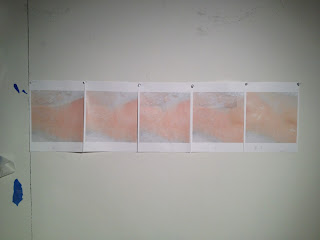DECEMBER 2, 2012
Entering Julia Whitney Barnes' studio in Red Hook, Brooklyn, I encountered a world of interconnections, a
feast for the eyes. Two of the walls are covered with rich source material,
including studies, photos and reproductions of images of animals, plants,
architecture, a favorite painting: Pontormo’s Visitation and a view from her studio window in
Italy. Surrounding herself with
this imagery, Julia explores relationships between art, science and mythology,
and natural and human-made worlds. Integrating her ideas, she flexibly moves
among oil painting, printmaking, ceramics, mural painting, mosaic work and
installation, creating studio and public works. Her work is influenced by
ecological practices and the complex relationship humans have had with the
environment throughout time.
For Collectively
Assembled, I chose a painting in progress (oil paint, ink
and watercolor on linen stretched over wood.) This piece explores private vs.
public and is a good fit for the unique A@R
space with its reconverted showers, green areas, courtyard and public programs.
Initially Julia associated the blue atmosphere with the sky, but after
Hurricane Sandy this aquatic color took on new meaning. The prison-like tower
is a remnant from an abandoned amusement park. She incorporates the
labyrinthine floor pattern of San
Vitale in Ravenna, leading our eye back to the center of the painting. Its
perfect triangles have been made irregular with the passing of time. We also
see nature at work on the contemporary fence in the foreground. Julia observes,
“Nature permeates human-made structures. Humans build barriers, yet long for
reunification with nature, a constant cycle occurring throughout centuries.”
The adaptable trees, growing through the fence, have been cut down to truncated
branches. The trees weave in and out of the fence, itself a woven form.
Repeated triangle and diamond patterns bring the eye around the entire
painting.
A diptych, Star
Island (hand-colored etching with shellac-based ink and
watercolor,) will also be included in the show. Star Island is a real island
off the coast of NH, where Julia spent time as a child. In this diptych, she
explores how the isolated feeling of the island is conducive to fantasy. The
atmospheric pink coloring breathes throughout both images like the sky at dawn
or dusk. The star print fuses patterns from various cultures, including Celtic
and Islamic. Julia is interested in how patterns affirm universality among
cultures and are distilled from nature. She creates patterns within patterns and
the star arrows are multidirectional and continuous in movement. In the
landscape print, Julia explores her love for the work of Patrick
Blanc, trained botanist, artist and creator of vertical
gardens. She loves the ecological benefits of vertical gardens, planted on
building walls, and how these beautiful creations grow and change over time. In
this print, she also explores her fascination with a unique geological
structure, a karst formation in Phang Nga
Bay in Thailand. This rock formation has been
transformed by the rise of fall of the sea level. Time and natural processes
have turned it into a vertical garden structure. A ghost print of a spiral
staircase weaves around this image, creating an energy field.
It was wonderful to see
Julia and her work, and to learn about her inspirations. I look forward to
future studio visits!
Julia Whitney Barnes has
been a member of the tART Collective since
2006. She is on the faculty at Adelphi University. To learn more about her
work, visit www.juliawhitneybarnes.com




























